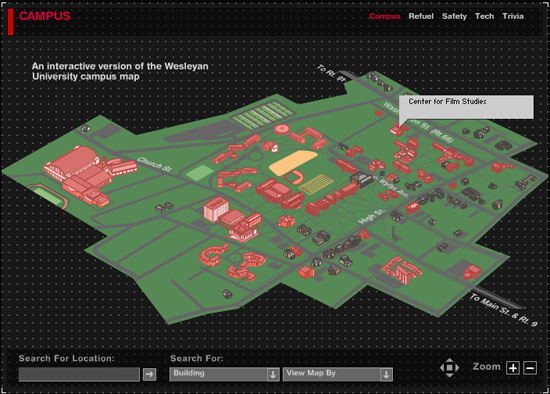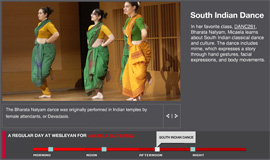“The Wesleyan Experience” is Wesleyan – Virtually
 |
 Wesleyan has launched a new virtual tour for the campus community and prospective students. Above, an interactive Wesleyan campus map highlights 50 campus buildings. At right, a part of a guided tour by a Wesleyan student. Wesleyan has launched a new virtual tour for the campus community and prospective students. Above, an interactive Wesleyan campus map highlights 50 campus buildings. At right, a part of a guided tour by a Wesleyan student. |
| Posted 06/15/05 |
|
Take a trip from Freeman Athletic Center to the Center for Fine Arts, locate all the wi-fi sites in between, find a place to eat, learn a little Wesleyan trivia and even see whats happening on campus all without ever leaving your computer. A new Web site called The Wesleyan Experience http://www.wesleyan.edu/virtualtour/ gives users a chance to do all this a more. The site combines online tours with interactive-campus-wide information using maps, audio, digital video and text presentations. The site was launched in May after more than a year of planning by the Office of University Communications and the Office of Admission. Originally, we wanted the virtual tour to give prospective students a glimpse into the day-in-the-life of a Wesleyan student, says Jennifer Carlstrom, Web manager and virtual tour project manager. But when we started building this, and adding campus maps and trivia, it became a tool for the whole campus community. From The Wesleyan Experience home page, users have the option of seeing the days events, going on campus-tours guided by three different students clicking into campus maps for information about specific campus locations and services. The campus map section of the site includes illustrations of all Wesleyan buildings. When a user mouses over a structure, the buildings name appears. Clicking on the building produces a pop-up window describing the facilitys purpose. Photographs accompany all descriptions. Users can obtain physical and factual information regarding all 50 buildings on campus. Events of the day are noted, computer labs and wireless zones are marked and the location of all the campus public safety call boxes are displayed. Users can quickly find locations and descriptions of the campuss seven eateries. A campus-wide Wesleyan trivia map is also available and provides fun and interesting facts that may come in handy as Wesleyan approaches its 175th anniversary. The student-hosted tours offer a different view of campus. Each tour is told from the particular students perspective, mixing audio, video and still photography. The guides lead viewers through their typical day of classes, sports practice, social events and extracurricular activities. The guided tour section of the site features three students, Nathan Victoria 05, Micaela Gutierrez, 07 and Al Asante 07. Viewers can sit through Nathans Wesleyan Student Assembly meeting; speak French with Micaela; or attend football practice and choir concert with Al. “Nathan, Micaela and Al’s daily routines are snapshots of what typical student life is like at Wesleyan University,” says Laura Perillo, associate director of media relations and copywriter for the project. “No two students share the same Wesleyan experience – each is quite unique – and our goal with the virtual tour is to highlight that for our perspective students.” Carlstrom and Perillo, along with World Wide Web administrator Pat Leone, Web designer Ryan Lee and former Web designer Sasha Foppiano designed the site. William Holder, director of Publications and David Low, associate director of Publications, assisted with the writing and editing; and William Burkhart, university photographer, photographed images used on the site. Nancy Meislahn, dean of Admission and Financial Aid provided funds for the project. Charlotte Lazor, associate director of the Admission Information System, and Kristen McQueeny, program and events coordinator for the Office of Admission, helped coordinate and conceptualize the site. Wesleyan had a virtual tour before, that basically replicated our walking tour, Lazor says. It was time to bring this tour into the 21st century. Now the virtual tour isnt just a tour it has many other dimensions. The site uses Macromedia Flash technology, a tool used for creating interactive and animated Web sites. Avenue A Razorfish, an interactive services firm, aided with the sites structure and back-end Flash technology. Since we were working with a younger audience, we thought we would create a flashy, interactive Web site, Carlstrom says. Were competing with movies and video games, so we thought by using Flash technology, wed be able to draw the audience in, and keep them interested. The site will be reevaluated during fall semester. The sites creators are planning to add incoming freshman as tour guides and add additional interactive buildings. “I hope the new virtual tour site is an easy, fun and interactive means by which perspective Wesleyan students can learn about academic and campus life, Perillo says. Perspectives are able to closely analyze different avenues that our Wesleyan students are known for exploring. It’s our hope that the virtual tour site is just as dynamic as each of our students.” |
| By Olivia Drake, The Wesleyan Connection editor |

